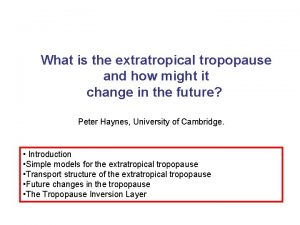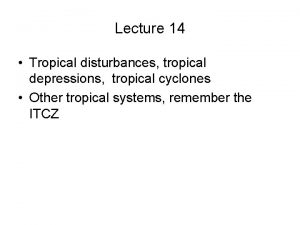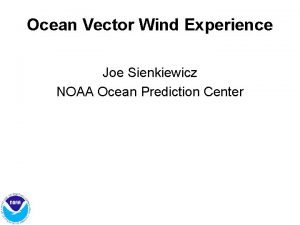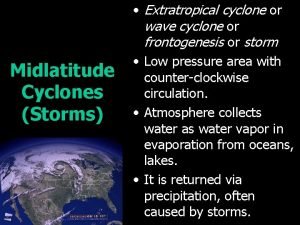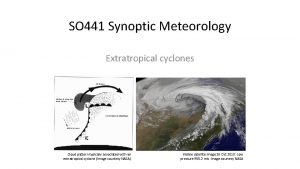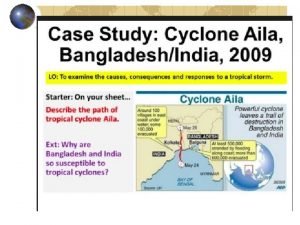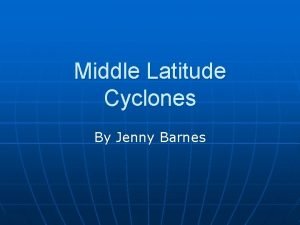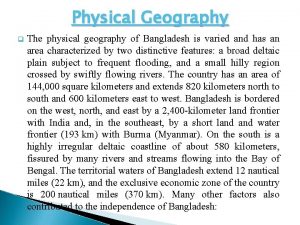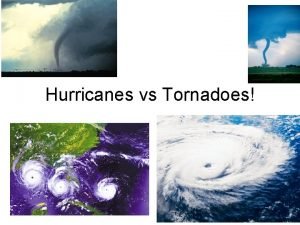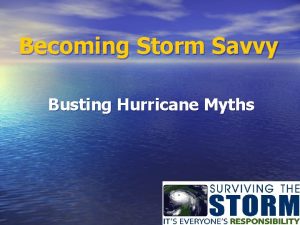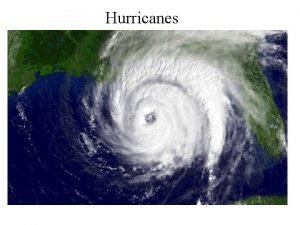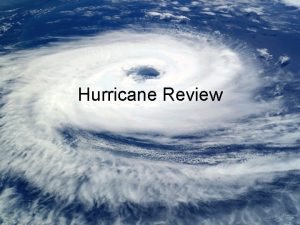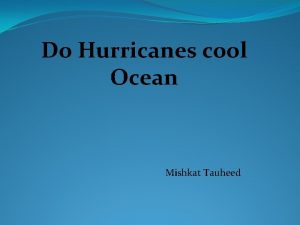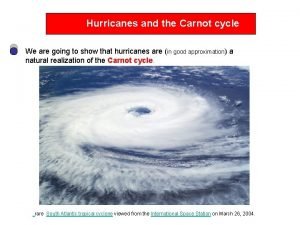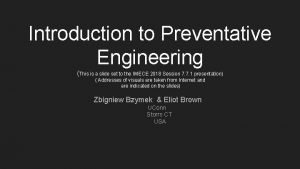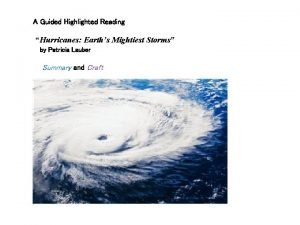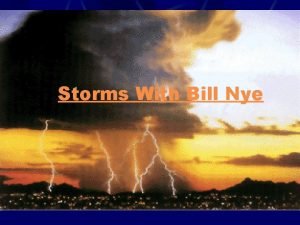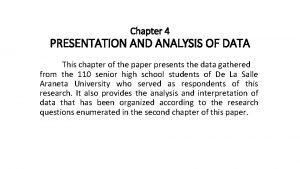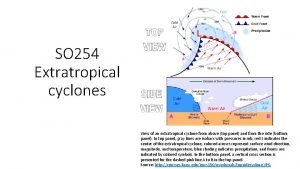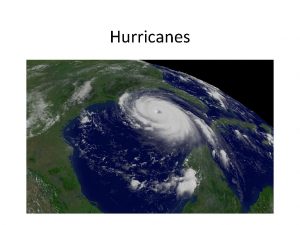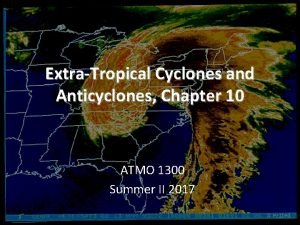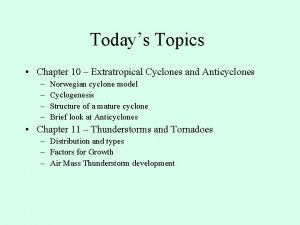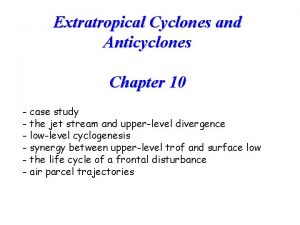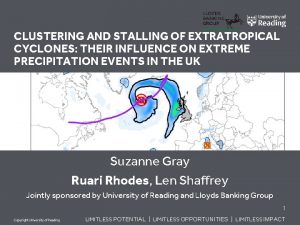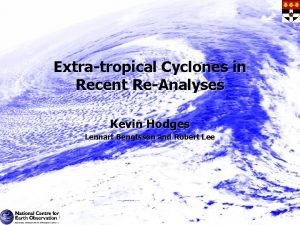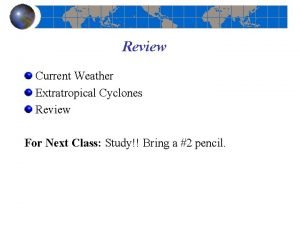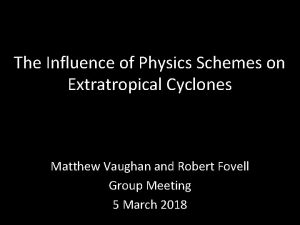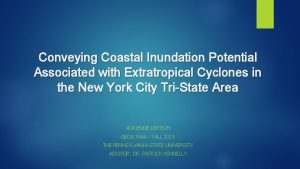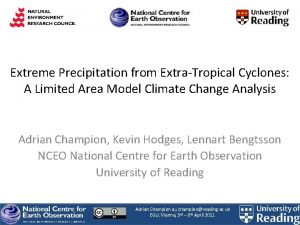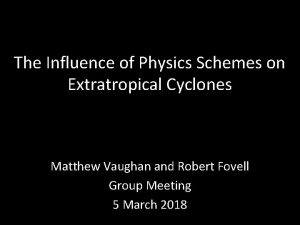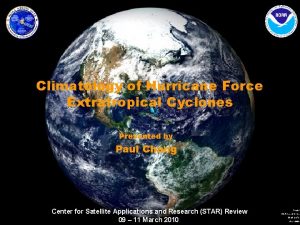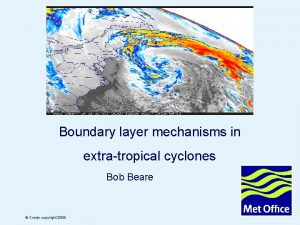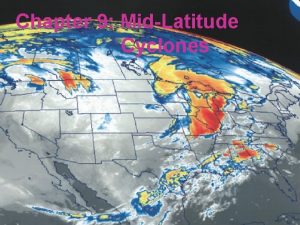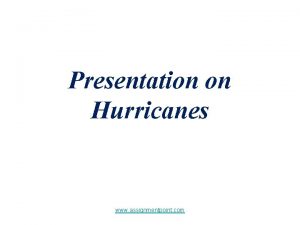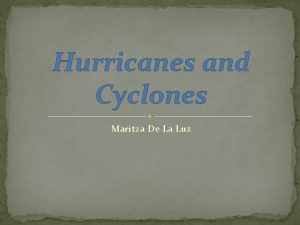Lecture Presentation Chapter 10 Hurricanes and Extratropical Cyclones












































- Slides: 44

Lecture Presentation Chapter 10 Hurricanes and Extratropical Cyclones © 2012 Pearson Education, Inc.

Learning Objectives § Understand the weather conditions that create, maintain, and dissipate cyclones § Understand the difficulties in forecasting cyclone behavior § Know what geographic regions are at risk for hurricanes and extratropical cyclones § Understand the effects of cyclones in coastal and inland areas © 2012 Pearson Education, Inc.

Learning Objectives, cont. § Recognize linkages between cyclones and other natural hazards § Know the benefits derived from cyclones § Understand adjustments that can minimize damage and personal injury from coastal cyclones § Know the prudent actions to take for hurricane or extratropical cyclone watches and warnings © 2012 Pearson Education, Inc.

Introduction to Cyclones § An area or center of low pressure with rotating winds § Counter-clockwise in Northern Hemisphere § Clockwise in Southern Hemisphere § Tropical or extratropical § Based on origin and core temperature § Characterized by intensity § Sustained wind speeds and lowest atmospheric temperature © 2012 Pearson Education, Inc.

Tropical and Extratropical Cyclones § Tropical Cyclones § § § Form over warm tropical or subtropical ocean water (5°– 20°) Have warm central cores Tropical depressions, tropical storms, hurricanes High winds, heavy rain, surges, and tornadoes Derive energy from warm ocean water and latent heat § Extratropical Cyclones § Form over land or water in temperate regions (30°– 70°) § Associated with fronts and cool central cores § Strong windstorms, heavy rains, surges, snowstorms, blizzards § Most do not produce severe weather § Derive energy from temperature contrasts along fronts © 2012 Pearson Education, Inc.

Classification § Nor’easter § Extratropical cyclone that moves along northward along East Coast U. S. § Hurricanes § Tropical cyclones in Atlantic and eastern Pacific Oceans § Typhoons § Tropical cyclones in Pacific Ocean west of International Dateline and north of the equator § Cyclones § Tropical cyclones in Indian Ocean § Saffir-Simpson Scale classifies hurricanes based on wind speed © 2012 Pearson Education, Inc.

Table 10. 1 © 2012 Pearson Education, Inc.

Naming § Extratropical storms are sometimes named after their origins § Example: Alberta Clipper § Hurricanes named by international agreement through World Meteorological Organization § Named once winds exceed 63 km (39 mi. ) per hour § Names assigned sequentially each year from list for each origin § Male/Female names alternated § Names are reused every 6 years § Names of big storms are retired (example: Katrina) © 2012 Pearson Education, Inc.

Cyclone Development: Tropical Disturbance § A organized mass of thunderstorms persisting for > 24 hours § Typically 200 to 600 km (120 to 370 mi. ) § Has a weak rotation due to Coriolis effect § Formed by § § Lines of convection Upper-level low pressure troughs Cold front remnants Easterly waves of converging and diverging winds § Atlantic Ocean hurricanes © 2012 Pearson Education, Inc.

Tropical Depressions and Tropical Storms § Tropical Depression § Tropical disturbance wind speeds increase and begins to spin § A low pressure center is formed § Tropical Storm § Winds increase to 63 km (39 mi. ) ph § Storm is given a name § Wind speeds are not at hurricane strength, but rainfall can be intense © 2012 Pearson Education, Inc.

Hurricanes § Not all tropical storms develop into hurricanes § Classified when winds reach 119 km (74 mi. ) per hour § Environmental conditions § Thick layer of warm ocean water § Water must be warm and there must be deep § Steep vertical temperature gradient § Atmosphere must cool quickly with increasing altitude § Weak vertical wind shear § Strong winds aloft prevent hurricane development. © 2012 Pearson Education, Inc.

Hurricane Structure § Rain bands § Clouds that spiral inward around center § Counterclockwise in Northern Hemisphere § Increase in intensity towards the center of the hurricane § Eyewall § Innermost band of clouds § Contain the greatest winds and rainfall § Eye § Area of calm at center of the hurricane § Narrow at surface and wider at top © 2012 Pearson Education, Inc.

Hurricane Structure, cont. § Warm, moist air spirals upward around eyewall § Air rises, it loses moisture § Upward rotation draws air from eye, causing dry air to sink back into center § Upward rotation also causes air to flow out the top of the storm concentrated in exhaust jets § Allows additional warm air to feed bottom of the storm © 2012 Pearson Education, Inc.

Figure 10. 14 © 2012 Pearson Education, Inc.

Hurricane Paths and Demise § Movement is controlled by the Coriolis effect and steering winds § In Northern Hemisphere storms deflect to the right § Track west in trade winds and curve northwest and then northeast § Hurricanes can make a loop § In North Atlantic, steered by Bermuda High § As hurricane moves over land, it loses energy (warm water) § Can become extratropical cyclone © 2012 Pearson Education, Inc.

Extratropical Cyclones § Necessary conditions § Strong temperature gradient at surface usually along cold, warm or stationary fronts § Strong upper level winds provided by jet stream § Polar jet stream § Subtropical jet stream Figure 10. 18 © 2012 Pearson Education, Inc.

Polar and Tropical Jet Stream § Polar jet stream shifts from crossing the United States in the winter to crossing southern Canada in the summer § Subtropical jet stream crosses Mexico and Florida and is strongest in the winter § Large high-pressure ridges and low-pressure troughs cause jet streams to bend and producing waves or meanders § May also split in two around isolated high-pressures and reunite § Extratropical cyclones often develop in curves or divergences in jet streams © 2012 Pearson Education, Inc.

Polar and Tropical Jet Stream, cont. § Bending or splitting cause the polar jet stream to dip south and the subtropical jet stream to flow northeast § The southern branch of a split polar jet stream in the Pacific Ocean brings warm moist air out of the tropics § West Coast forecasters refer to the flow of warm moist air as the Pineapple Express, because of its origin near Hawai’i § Nor’easters form when bends of the polar and subtropical jet streams begin to merge off the southeastern coast of the United States © 2012 Pearson Education, Inc.

Extratropical Cyclone Development § Low-pressure center develops along frontal boundary § Cold front on southwest, warm front on east § Conveyor belt of cold air circulates counter-clockwise § Warm air is wedged to the east § Conveyor belt of warm air rises on the southeast side creating a comma § Conveyor belt of dry air aloft feeds the cyclone from behind the cold front § Cold front wraps around the warm front, causing an occluded front develop trapping warm air aloft § Cold air completely displaces the warm air, pressure gradient weakens and storm dissipates © 2012 Pearson Education, Inc.

Figure 10. 20 © 2012 Pearson Education, Inc.

Figure 10. 21 © 2012 Pearson Education, Inc.

Geographic Regions at Risk for Cyclones: North America § Hurricanes threaten contiguous United States, Puerto Rico, the Virgin Islands, and U. S. territories in the Pacific Ocean § They are a lesser threat to Hawai’i and Atlantic Canada § On the Pacific coast, hurricanes strike Baja California and the west coast of the Mexican mainland Figure 10. 22 © 2012 Pearson Education, Inc.

Atlantic Hurricane Paths § West toward East coast of Florida, sometimes passing over Caribbean § Move out into the Atlantic Ocean to the northeast § Westward over Cuba and into the Gulf of Mexico to strike the Gulf Coast § Westward to the Caribbean and then northeastward skirting the East Coast § May strike the continent from central Florida to New York Figure 10. 17 © 2012 Pearson Education, Inc.

Figure 10. 24 © 2012 Pearson Education, Inc.

Geographic Regions at Risk for Cyclones: Worldwide § Northwest Pacific is much more active than North Atlantic § Indian Ocean is also a very active hurricane zone § South Atlantic and southeast Pacific, rarely have hurricanes because of cold ocean water § Hurricanes do not form close to the equator because of the absence of the Coriolis effect © 2012 Pearson Education, Inc.

Figure 10. 25 © 2012 Pearson Education, Inc.

Geographic Regions at Risk from Cyclones, Summary § Tropical cyclones § East and Gulf Coasts § Hawaii and Atlantic Canada § Baja California and West Coast Mexico § Extratropical cyclones § Winter windstorms in Pacific Coast § Winter snow Sierra Nevada, Rocky Mountains and east § Spring and summer thunderstorms and tornadoes in United States and Canada © 2012 Pearson Education, Inc.

Cyclone Effects: Storm Surge § Local rise in sea level resulting from storm winds § Can be > 3 m (10 ft. ) § Because of spinning, surge is greatest in right quadrant of storm as it makes landfall § Height is greatest near time of maximum winds § Height is also greater if landfall coincides with high tide © 2012 Pearson Education, Inc.

Figure 10. 26 © 2012 Pearson Education, Inc.

Effects on Storm Surge Magnitude § Largest effect from stress exerted by wind on water § Fetch refers to the area over which the wind blows § Larger fetch results in larger storm surge § Smaller effect from low atmospheric pressure in storm pulling up on water surface § Also depends on shape of coastline § Water level tends to increase continually as storm approaches © 2012 Pearson Education, Inc.

Cyclone Effects: High Winds § Described by Saffir-Simpson Scale § Decrease exponentially with landfall § Strongest recorded winds in United States from extratropical cyclone § Responsible for strong winds in blizzards and tornadoes © 2012 Pearson Education, Inc.

Cyclone Effects: Heavy Rains § Average hurricane produces trillion gallons of water § Rainfall from cyclones can cause inland flooding § Flooding affected by: § § Storm’s speed Land elevation over which the storm moves Interaction with other weather systems Amount of water in soil, streams and lakes prior to storm © 2012 Pearson Education, Inc.

Links to Other Natural Disasters § Coastal erosion § Flooding § Mass wasting § Other types of severe weather § Tornadoes, severe thunderstorms, snowstorms, and blizzards © 2012 Pearson Education, Inc.

Natural Service Functions of Cyclones § Source of precipitation § Redistribute warm air from tropics § Maintain ecosystems § § Winds carry plants, animals, and microorganisms Waves stir up deeper, nutrient-rich waters Winds topple weak and diseased trees in forests Waves break apart some corals © 2012 Pearson Education, Inc.

Human Interaction with Cyclones § Urbanization of vulnerable coastlines increases magnitude of the effect of cyclones § Destruction of sand dunes makes areas more susceptible to hurricane winds § Construction of seawalls and bulkheads reflect waves and contribute to beach erosion § Poor building materials and practices can make hurricanes more dangerous to people § Global warming may contribute to higher intensity and frequency of hurricanes in the future © 2012 Pearson Education, Inc.

Minimizing the Effects of Cyclones: Forecasting and Warnings § Forecast includes: § § § If it will make landfall Where and when Wind strength Rainfall amount Storm surge § Monitored by U. S. Hurricane Center, Canadian Hurricane Center § Hurricane watch means likely hurricane in 36 hours § Hurricane warning given when hurricane is likely within 24 hours or less © 2012 Pearson Education, Inc.

Forecasting Tools § Weather satellites § Detect early warning signs § Can not show wind speed § Aircraft § U. S. Air Force, NOAA airplanes fly into the storm to collect data § Doppler radar § Give information on rainfall, wind speed, and direction of the storm © 2012 Pearson Education, Inc.

Forecasting Tools, cont. § Weather buoys § Automated weather stations that give information at their locations § Computer models § Predict and track hurricane progress § Have vastly improved hurricane information § Still lacking in predicting storm intensity © 2012 Pearson Education, Inc.

Figure 10. 32 © 2012 Pearson Education, Inc.

Storm Surge Predictions § Predict the time and elevation of surge § Forecasters use wind speed, fetch and average water depth § Need detailed information on topography § Different elevations on land affect the storm surge § Computer models use central pressure, size, forward speed, track, wind speed, and seafloor topography © 2012 Pearson Education, Inc.

Hurricane Prediction and the Future § Deaths have decreased dramatically because of better forecasting, improved education, and greater public awareness § However, coastal populations are increasing, increasing risk © 2012 Pearson Education, Inc.

Perception of and Adjustment to Cyclones § Perception of hazard depends on personal experience § More experienced people may take hazard more seriously § More seasoned people may also take less precautions § Community adjustments to cyclone hazard § § Warning systems Evacuation plans and shelters Insurance Building design © 2012 Pearson Education, Inc.

Perception of and Adjustment to Cyclones, cont. § Personal adjustments to cyclone hazard § § § § Be aware of hurricane season Prepare homes and property for hazard Obtain flood insurance Install heavy shutters that can be latched Learn evacuation route Make a family emergency plan Collect emergency supplies © 2012 Pearson Education, Inc.

End Hurricanes and Extratropical Cyclones Chapter 10 © 2012 Pearson Education, Inc.
 Inversion layer
Inversion layer Ciclone extratropical
Ciclone extratropical Extratropical cyclone
Extratropical cyclone Mid latitude wave cyclone
Mid latitude wave cyclone Extratropical cyclone
Extratropical cyclone Describe the distribution if tropical storms
Describe the distribution if tropical storms What are middle latitude cyclones
What are middle latitude cyclones Bangladesh physical geography
Bangladesh physical geography Mt air mass
Mt air mass Compare and contrast hurricanes and tornadoes
Compare and contrast hurricanes and tornadoes Difference between cake and brownie
Difference between cake and brownie 01:640:244 lecture notes - lecture 15: plat, idah, farad
01:640:244 lecture notes - lecture 15: plat, idah, farad Hurricanes vs tornadoes
Hurricanes vs tornadoes Hurricanes myths and facts
Hurricanes myths and facts Lecture presentation software
Lecture presentation software How are hurricanes categorized
How are hurricanes categorized Hurricanes definition
Hurricanes definition At the periphery of a hurricane the air is ____
At the periphery of a hurricane the air is ____ Bibliography
Bibliography Hurricane carnot engine
Hurricane carnot engine Hurricanes tropical storms
Hurricanes tropical storms Why do hurricanes lose strength over land
Why do hurricanes lose strength over land Hurricanes earth's mightiest storms
Hurricanes earth's mightiest storms Bill nye hurricanes
Bill nye hurricanes Fetal lie
Fetal lie Vertex presentation and cephalic presentation
Vertex presentation and cephalic presentation Human resource management 15th edition
Human resource management 15th edition Human resource management lecture chapter 1
Human resource management lecture chapter 1 Human resource management lecture chapter 1
Human resource management lecture chapter 1 Chapter 4 presentation of data
Chapter 4 presentation of data Magnetism
Magnetism Power system dynamics and stability lecture notes
Power system dynamics and stability lecture notes Microbial physiology lecture notes
Microbial physiology lecture notes Limits fits and tolerances
Limits fits and tolerances Parallel and distributed computing lecture notes
Parallel and distributed computing lecture notes Fundamental deviation table
Fundamental deviation table Financial institutions and markets lecture notes ppt
Financial institutions and markets lecture notes ppt Indirect finance
Indirect finance Extempore and lecture
Extempore and lecture Utilities and energy lecture
Utilities and energy lecture Pride and prejudice lecture
Pride and prejudice lecture Introduction to mechatronics ppt
Introduction to mechatronics ppt Foetotomy
Foetotomy Lecture on love courtship and marriage
Lecture on love courtship and marriage Power system dynamics and stability lecture notes
Power system dynamics and stability lecture notes
